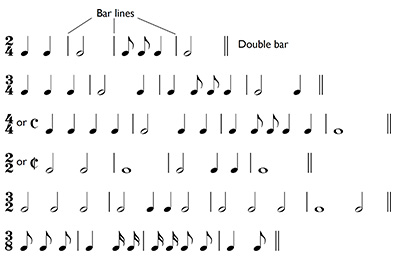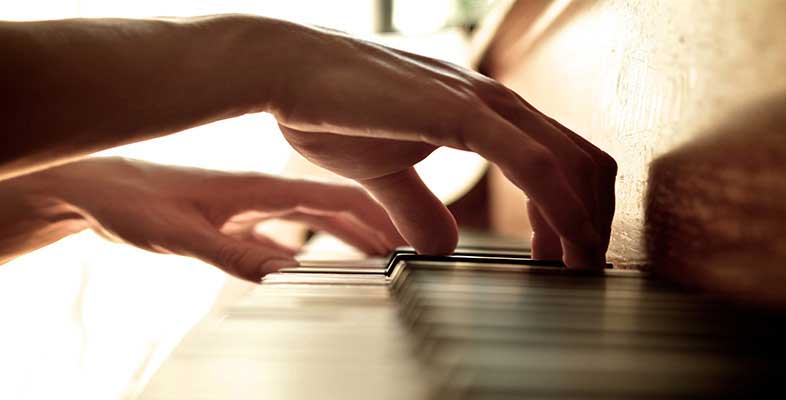3.3 Time signatures
The rhythm of a piece of western music – whether it is simple or complex – is underpinned by a steady pulse or beat, and these beats are grouped together to give the music’s metre. The music examples in this section include a click track to help you follow the beats. The most common groupings are in twos, threes and fours and these groupings are created by a pattern of stronger and weaker stresses. Thus, a three-beat pattern would consist of strong-weak-weak beats. In notated music, each group is marked out by a bar line – so from now on we will talk about how many beats there are in each bar.
Time signatures, which consist of two numbers aligned vertically, are placed at the opening of a piece of music to signify which metre is being used. (The time signature is then omitted for the rest of the piece, unless it is changed to another.) In the time signatures discussed in this section, the lower figure can be understood as the value of each beat expressed in relation to a semibreve (whole note). The number 2 represents a minim (half note), 4 represents a crotchet (quarter note), 8 represents a quaver (eighth note), and so on. The upper figure tells you the number of beats in the bar.
- In 2/4 there are two crotchets per bar. The lower number, 4, represents a crotchet because there are 4 crotchets (quarter notes) in a semibreve (whole note), and the upper number tells you that there are 2 beats, i.e. two crotchets, in a bar.
- In 3/2 there are three minims per bar. The lower number, 2, represents a minim because there are 2 minims (half notes) in a semibreve, and the upper number tells you that there are 3 beats, i.e minims, in a bar.
- In 3/8 there are three quavers per bar. The lower number, 8, represents a quaver because there are 8 quavers (eighth notes) in a semibreve, and the upper number tells you that there are 3 beats, i.e. quavers, in a bar.
Example 16 summarises the meaning of these three time signatures.
Example 16

Example 17 shows various straightforward rhythms in different time signatures.
Example 17

Notice in Example 17 that 4/4 can also be written as C (Common time), and 2/2 as a C with a vertical stroke through it (alla breve). Notice too that each bar includes the correct number of time values to make up the required number of beats shown by the upper number of the time signature, and that each bar’s group of beats is marked off with a bar line for ease of reading. Finally, the concluding bar line is written as a double bar.
Consider Example 17 carefully, spending as much time as you need in order to become proficient at adding together the number of beats in each bar, as signified by the top number of the time signature. (Pay particular attention when there are shorter values present such as quavers and semiquavers.) Additionally, make sure that you have identified the beat correctly as shown by the bottom number in the time signature – is it a minim (2), a crotchet (4) or a quaver (8)?
